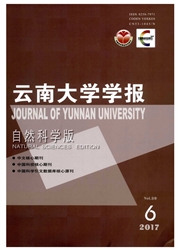

 中文摘要:
中文摘要:
利用构建的启动子探针载体pUE,以大肠杆菌(Escherichia coli)DH5α作为宿主菌,从耐低温假单胞菌(Pseudomonas sp.)菌株MY1402分离基因启动子片段,获得7个具有不同大小的启动子功能片段的重组子,命名为pUE1~pUE7.将其中具有p1片段的重组子PUE1导入假单胞菌MY1402中进行卡那霉素耐受浓度分析,结果显示阳性转化子MY1402/pUE1的最高耐受浓度为250 mg/L,而且在相同抗生素浓度下培养温度从28℃降到15℃并不影响转化子MY1402/pUE1的生长,表明pUE1中的插入片段p1具有低温启动子的活性.将所预测的p1核心序列p1a通过化学合成并连接到探针载体pUE上,构建出重组质粒pUE1a并转化MY4102中进行功能分析.结果显示,28℃条件下p1a片段仍保持相同强度的启动子活性,但15℃条件下活性下降明显,卡那霉素质量浓度高于100 mg/L基本没活性,表明p1a两端序列可能与p1低温转录启动活性有关.
 英文摘要:
英文摘要:
Promoter probe vector pUE was constructed and used to isolate DNA fragments with promoter activity from a Pseudomonas sp.strain MY1402 which can grow at low temperatures.Escherichia coli strain DH5α was used as a host for this study.Seven recombinant plasmids containing seven fragments of different size were obtained.One of the plasmids pUE1 which contained fragment p1 was transformed into MY1402 for promoter activity analysis.The results showed that the highest kanamycin concentration that the positive transformant MY1402/pUE1 could resist was 250 mg/L.Promoter activity of pUE1 at low temperature was also analyzed,similar growth rate of MY1402/pUE1 at 15 ℃ to that at 28 ℃ was observed,which indicated that fragment p1 had promoter activity at low temperature.Predicted core sequence p1a of the fragment p1 was synthesized and subcloned into pUE,generating recombinant pUE1a.Using the same methods,promoter activity of pUE1a was subjected to analyze.The results showed that the promoter activity of the predicted core sequence p1a was almost as strong as that of p1 at 28 ℃ but decreased significantly at 15 ℃,no obvious growth of MY1402 transformed with pUE1a was observed in the presence of kanamycin concentrations over 100 mg/L at 15 ℃,indicating the flanking sequences were involved with the promoter activity of p1 at low temperature.
 同期刊论文项目
同期刊论文项目
 同项目期刊论文
同项目期刊论文
 Identification and characterization of a helicase-like protein encoded by a Thermus siphoviridae pha
Identification and characterization of a helicase-like protein encoded by a Thermus siphoviridae pha 期刊信息
期刊信息
